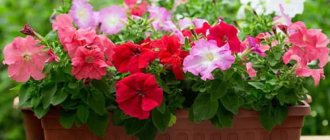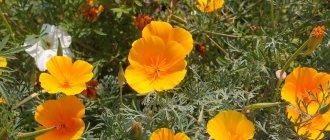Domestic amateur flower growers know graceful zinnia (Zinnia elegans Jagc.) as “majors”, “gentlemen”, “Cossacks”, “grandmother’s flowers” and under other popular names. This annual decorative and floral crop of the Asteraceae family is now experiencing a new wave of popularity, as many interesting modern forms have appeared in recent years. “Graceful” flowers are propagated by seeds, grown in seedlings in almost all regions of our country (except the southern ones). For those who are hearing about this summer plant for the first time, we invite you to understand in detail and find out how and when to plant zinnia seedlings in 2022.
Zinnia (pictured) is of great interest to landscape designers, as it combines wide application possibilities and high decorative properties.
When planning the time of sowing seeds for seedlings, it is important to take into account local climatic conditions and varietal characteristics. If you wish, you can follow the recommendations of the “lunar” sowing calendars, choosing the most favorable days.
Thanks to the work of breeders, modern varieties and hybrids are free of many of the shortcomings that were characteristic of their predecessors. The most popular among domestic summer residents are pompom and dahlia varieties.
Tall (60-85 cm) zinnias are distinguished by a wide variety of flower shapes and colors and are actively used in all types of flower decoration, usually in group plantings. Dwarf (15-30 cm) plants are perfect for growing in container culture - in pots or flowerpots on balconies and terraces, as well as for forming low borders along paths. A list of officially recognized varieties, well adapted and approved for landscaping throughout the country, can be found in the State Register of the Russian Federation.
An experienced florist talks about his favorite varieties and their benefits in the following video review:
Spectacular flowers are suitable for cutting, as they retain their freshness and bright color for a long time in a vase with water.
Description of zinnia
Zinnia is an annual and perennial herb or subshrub of the Asteraceae family. Gardeners most often grow two types - narrow-leaved and graceful. In total, there are about 20 of them in nature. Annual zinnias are actively cultivated. Plant varieties have different heights, some dwarf varieties do not exceed 30 cm. A bush is considered medium-sized if its stem reaches 70 cm, and tall if it is more than one meter.
The inflorescences-baskets are large, of various shapes, brightly colored. They are divided into the following types:
- scabiosa;
- cactus-like;
- chrysanthemum-shaped;
- Californian;
- dahlias;
- pompoms.
The last three are especially popular among gardeners.
Advice! When choosing a variety, it is necessary to take into account that terry specimens are more capricious in cultivation than semi-double or ordinary zinnias.
Pompon zinnia is also called lilliputian; its stems do not grow higher than 0.5 m. The bush is compact and branched, looks very decorative. The flowers are double, about 5 cm in diameter, densely covering the shoots. Often several bushes of different varieties are grown together so that the flower bed does not lose its decorative effect until the fall. The flower dies at temperatures below - 1 ° C, so when growing it you need to monitor the weather. The color of the petals does not fade in the sun. The most famous varieties are Tom-Thumb and Rotkopchen.
Dahlia zinnia is distinguished by large double flowers and a high, about 1 m, stem. The color of the buds can be different - white, yellow, crimson, pink, purple. The size of the flowers reaches 15 cm. A popular variety of dahlia-shaped zinnias is Polar Bear. It has white flowers and a height of 70 cm.
Also often grown on plots are the Dream variety with pink flowers, and the Violet variety with purple buds. Both plants are about 1 m high and have voluminous double flowers.
California zinnia also has large flowers and a tall stem. The plant is strong and can exist calmly without support. The diameter of the inflorescences is 10-15 cm, the color is bright. On sale you can find a California mixture, when grown, you get a ready-made colorful flower bed.
Annual zinnia flowers are propagated by growing them from seeds. The varietal characteristics are preserved.
Seed preparation
How long to soak zinnia seeds before planting and is it worth doing it at all? Soaking is not necessary, but it allows you to select the best seeds from a variety of seeds.
Usually the strongest and most viable seeds are those collected last season. They begin to develop roots within 2-3 days. Old ones can sit for a week or longer before germinating.
The scourge of seedlings is fungal infections that can destroy zinnias at the very start of their development. To avoid infection with blackleg, powdery mildew, gray mold or root rot, the seeds are treated with a complex fungicide before planting.
Preparations such as Maxim and Topaz ; they are also successfully used when growing zinnia from seeds. Photos of plants affected by these diseases can be seen below.
IN THE PHOTO: Black leg.
IN THE PHOTO: Powdery mildew.
IN THE PHOTO: Gray mold (botrytis).
In addition, before planting the seeds in the ground, it is advisable to treat the zinnia seed to prevent leaf spot.
IN THE PHOTO: Leaf spotting.
Fitosporin-M or Abiga-Pik will cope well with this task. Already grown plants can be protected from insects (aphids, spider mites), slugs and snails by treating them with Imidor and Groza.
How to collect zinnia seeds
To collect zinnia seeds, choose the most beautiful flower and, when it withers and ripens, cut it. The seeds are completely ready no earlier than 60 days, so the material is chosen from the first ones grown in the flowerbed. At the same time, they are also guided by the fact that early flowers are the brightest and largest. That is, some selection work is carried out - the best specimens are selected for reproduction.
If the seed head is not dry enough, you can let it sit longer. It should be brown in color. To extract the seeds, carefully remove the petals and remove the seed from the center of the basket. Then follows sorting, additional drying and packaging in paper bags. You can still sort, but this is relevant if you decide to propagate and use only one type of zinnia for growing.
You can see what zinnia seeds look like in the photo:
Store seeds in a cool, dark place. The main thing is to ensure that mold does not form and to avoid fungal infections.
Subtleties of growing zinnias
Where to get seeds
Typically, zinnia seeds are either collected from faded plants or purchased at the store. In the first case, you receive planting material adapted to your climatic conditions (if you collect it in your region).
Then, most likely, the flowers will grow well and will be exactly like their parent specimens.
The exception to this rule is F1 hybrids grown from purchased seeds. As a rule, the offspring of F1 hybrids lose part or all of their parental characteristics. For example, if F1 was double, then its seeds can produce simple daisy flowers, or at best semi-double. The same applies to color, habit (plant shape) and other unique varietal characteristics.
The seeds are thin sticks in the center of a brown and dried flower.
IN THE PHOTO: Zinnia seeds are small and light. They are easy to lose during manual collection, so it makes sense to break off the dried basket of seeds, put them in a bag and sort them out at home on a sheet of clean white paper or a smooth, light-colored surface.
If the petals crumble in your fingers, and the contents of the box crumble when touched, you can start collecting.
Cut off the flower heads with sharp scissors, remove the seeds indoors and place them on a sheet of paper to dry. You can store seed in a jar with a lid or in a paper envelope in a cool, dry place. Planting zinnia seeds will be successful only if they are of excellent quality and properly stored.
Planting zinnia for seedlings
The plant is afraid of cold weather, so it is important to plant it when warm weather sets in. In general, caring for a flower is not difficult. Growing zinnia from seeds at home is accessible to anyone.
Sowing dates for zinnia
To understand when to plant low-growing zinnia when growing from seeds, you need to take into account that it will germinate very quickly and the seedlings will begin to actively develop. The optimal time is mid-April. The seedling period is 5-6 weeks.
Selection of capacity
Typically, seedling boxes are chosen for growing seeds. Their height should be about 10 cm. The boxes are filled ⅔ with soil, this is quite enough for successful seed germination.
Advice! It is convenient to plant zinnia immediately in separate pots, this way you can avoid picking.
Soil preparation
Growing zinnia seeds can be done at home, as well as in a greenhouse. For all plants of the Asteraceae family, the substrate is prepared in the same way. It is necessary to take peat, sand, turf soil and humus in equal proportions. Special stores have ready-made soil mixtures.
When independently preparing a substrate for growing seedlings, all its components must be thoroughly steamed or treated with a solution of potassium permanganate. In this way, diseases and pests that may be present are destroyed. It will be much easier to grow zinnia from seeds in prepared soil.
Seed selection and preparation
One basket contains several types of seeds:
- flat shield-shaped;
- sharp spear-shaped;
- sharp with an awl-shaped tail.
They are sorted separately, because different seeds of one flower will produce different plants. From corymboses, simple zinnias arise, without signs of doubleness, even if the parent culture had these characteristics. Seeds in the form of copies when grown form regular or semi-double specimens. But the awl-shaped form will lead to the formation of large double flowers. Such seeds can be found in the outer row of a dried basket. It is better for beginning flower growers to master ordinary non-double varieties of zinnias for growing, as they are easier to care for.
Large seeds are easy to sort and are not subject to additional processing. This fact also contributes to the wide distribution of the flower among gardeners. However, if you soak the seeds in Epin, they will sprout faster and more quickly. For those who like to do everything as naturally as possible, this stage can be skipped; the plant’s germination rate is already good.
Seed sowing scheme
If further picking is expected during cultivation, then the seeds can be arranged quite densely. But sowing at a distance of 4 cm from each other will avoid this procedure. When the seedlings gain strength and tighten up, they are sprinkled with nutritious soil. During the growing process, the stems form adventitious roots, and the plant will continue to develop normally.
Attention! Immediately after sowing, the containers are covered with film and the boxes are put away in a dark and warm place. Shoots will begin to appear on the 3-4th day. During this period, the cover is removed from the boxes.
Popular questions and answers
We talked about growing zinnias with agronomist-breeder Svetlana Mikhailova.
How long do zinnia seeds remain viable?
The germination capacity of zinnia seeds lasts 4–5 years, which is why it decreases. However, zinnia initially has a low germination rate - about 40%, so the poet needs to buy seeds with a reserve.
How to use zinnias in landscape design?
The ideal option is a mixborder of different varieties of zinnia with similar shades, for example, pastel. You can add several spectacular spots from bright varieties to the composition. Among other plants, zinnia goes well with lupins, heucheras, hosts, bergenia and chistets.
Is it possible to grow zinnias at home on a windowsill?
Quite, but it’s even better on the balcony and it will be great if it’s sunny - there’s an ideal place for zinnias.
But you need to choose low-growing varieties, for example, Thumbelina, Pulchino, Peter Pan, Lilliput - their height is 25 - 50 cm. Sources
- Kudryavets D.B., Petrenko N.A. How to grow flowers. Book for students // M.: Prosveshchenie, 1993 – 176 p.
- Tavlinova G.K. Flowers in the room and on the balcony (2nd ed., revised and additional) // L.: Agropromizdat, Leningrad branch, 1985 - 272 p.
- Kiselev G.E. Floriculture // M.: OGIZ – SELKHOZGIZ, 1949 – 716 p.
Caring for zinnia seedlings
Caring for zinnia seedlings when grown from seeds is not difficult. It includes standard procedures. And if at the planting stage you do it in such a way as to avoid picking, then care becomes even easier. A measure such as strict adherence to certain rules will allow you to grow good zinnia seedlings at home.
Picking up seedlings
If the seeds were initially sown thickly, then over time they will not have enough nutrients. When growing, it will be necessary to provide them with a large area. Young plants are carefully removed from the container in which they were located and placed in larger containers or in separate pots.
After transplanting, it is necessary to protect the crops from direct sunlight and provide them with watering. During the growing period, seedlings must be protected from drafts.
Hardening of seedlings
Before placing zinnia in a permanent place of cultivation in the flower garden, it must be hardened off. You should spend at least a week on this procedure, 14-16 days would be optimal. Hardening begins with opening the window for a short period. The flower will thus feel the fresh air.
Then, in good weather, the seedlings are taken to the balcony or outside. It is advisable to carry out hardening immediately at the dacha, this makes it easier to control the ambient temperature and the time spent outdoors. In addition, the zinnia will be in conditions as close as possible to the conditions of its further existence.
Necessary conditions for development
The less zinnia undergoes transplants in its life, the better. Therefore, initially, holes 1 cm deep are created for seeds in pre-moistened soil at a distance of 5–8 cm from one another. You can place 1 or 2–3 grains in each, but in the second case, as soon as the sprouts appear, the excess ones are removed, leaving only one and the strongest. Then the planted seeds are lightly sprinkled with soil and watered with a spray bottle.
Growing poppies on your own site: what types of flowers can be planted in a flower bed
Creating a greenhouse effect under glass or film is not necessary, but if drafts are possible where the planting container is located, then it is better to play it safe.
Zinnia seedlings, depending on the freshness and quality of the seeds, appear in 2–8 days.
In order for the vegetation cycle of plants to have the most favorable start, the following conditions are required:
- The air temperature before seed germination is within the range of +22…26 °C.
- The air temperature after the sprouts appear is +18…20 °C during the day and +16…18 °C at night.
- Clear diffused light 12–14 hours a day with mandatory additional lighting in cloudy weather during the day.
- Watering to prevent the soil from drying out.
If zinnia seedlings begin to stretch out, you can help them by deepening them, in which soil, without compacting, can be poured onto the adventitious roots that have formed and appear above the surface.
Planting seedlings in open ground
The best time to move zinnia grown from seeds into open ground is the end of May and the beginning of June. It is important that there are no frosts at this point, otherwise the plant will simply die.
The planting site is selected based on the varietal characteristics of the plant:
- tall Californian zinnias, as a rule, get a place in the background; they often hide unsightly parts of the garden;
- varieties with medium height can be placed anywhere, most often they are in the center of the flower bed, but can also be grown in flowerpots;
- low-growing specimens are placed in the foreground of flower arrangements, used in borders, and they are also good for balconies.
Since the flower petals do not fade, the plant is safely placed in sunny places. It does not tolerate growing in shade. In this case, open sunlight would be preferable. The bushes branch heavily, so the optimal distance for planting them will be 30-35 cm. This way, each plant will have enough nutrients, and caring for it will be easier. There will be enough space for weeding and loosening.
When growing seedlings in peat pots, replanting is greatly facilitated - the seedling is placed in the ground along with them. When removing roots from ordinary containers, you must be careful not to damage them. An uninjured plant will take root better and grow stronger faster.
Further care of zinnia in open ground when grown from seeds is not difficult:
- Watering can be rare, but plentiful. It is necessary to ensure that the stream does not touch the peduncle, otherwise it may begin to rot. Faded and rain-damaged parts of the plant are promptly removed.
- If you want to make the bush lush and low, pinch it. Without this procedure, the stem will grow in height. Pinching is done when the plant has a sufficient number of leaves; the central stem is removed above the third or fourth pair of leaves.
- Loosening the soil should be done regularly, especially after watering or rain. The main thing is to prevent the formation of a crust, as it will impede oxygen access to the roots.
- Fertilizing is necessary only in case of deviations in growth or the presence of yellowing leaves. Complex fertilizers are used, which also prevent the occurrence of fungus. The solution is prepared in accordance with the instructions and applied under the zinnia bushes. You can use the drugs Gumax, Rose, Ideal.
Picking
The strong root system of zinnia adapts relatively easily after picking, but before planting in the ground it is better to do it only once - when the plants acquire 1 or 2 pairs of true leaves. Normally, by this time the seedlings should grow to 10 cm.
Now each flower is given an individual container with a volume of 200–250 ml.
When transferring, you need to try not to destroy the earthen lump. In a new place, the seedlings must be buried down to the cotyledon leaves, lightly compacting the soil.
1.5 weeks after picking, it is advisable to feed zinnia seedlings with liquid complex mineral fertilizer.
Low and medium-sized varieties of zinnias need pinching, which promotes proper formation, enhances branching and prevents stretching. Pinching is performed on 4–5 pairs of true leaves.
5 useful tips for planting catharanthus in open ground
Sowing dates by region
It should take about two months from the appearance of sprouts to the planting of grown bushes in the ground. They are planted in the flowerbed after the frost has passed. Therefore, the timing of sowing zinnia seedlings depends on the weather conditions in your region:
- In the Urals and Siberia you can sow in early April.
- In the Leningrad region - at the end of March.
- In the Moscow region and other areas of the middle zone - in mid-March.
- In the south (for example, in Crimea), zinnia seedlings can be planted as early as mid-February. Here, flowers are often sown directly into the ground in the spring and beautifully blooming flower beds are obtained in the summer.
Attention! With proper care and good weather, cactus-like tall zinnias bloom approximately 2.5-3 months from the moment of emergence.
By the way! If you are interested in finding out the favorable days for planting zinnia seedlings this year according to the lunar calendar, click on the link.











